Yellampalli S. (ed.) Carbon Nanotubes - Synthesis, Characterization, Applications
Подождите немного. Документ загружается.


Reinforced Thermoplastic Natural Rubber (TPNR) Composites
with Different Types of Carbon Nanotubes (MWNTS)
457
obtained indicate that the MWNTs content influences the thermal diffusivity values of two
types of multi-walled carbon nanotubes, as shown in Figure 13 and Figure 14.
As shown in Figure 13 and Figure 14, as the temperature increased from 30
o
C to 150
o
C,
there is a decrease in the thermal diffusivity. The maximum thermal diffusivity
was obtained at 30
o
C. However, after 30
o
C, there is a sudden drop in diffusivity. The
thermal diffusivity of MWNTs 1 dropped as did MWNTs 2 by increasing the test
temperature.
The thermal diffusivity of the TPNR/MWNTs decreases with fiber content due to the
density of the nanocomposites, which decrease with the increase in the amount of MWNTs
(the density of MWNTs less the TPNR density), hence, the density of the samples affects the
thermal diffusivity (Kumari et al., 2008). This means that the TPNR containing MWNTs fiber
will require a shorter time to be heated or cooled than the TPNR. Above 150 °C, the
temperature at which the TPNR starts to melt, a slight variation of the thermal diffusivity
with temperature is observed. The thermal diffusivity depends mainly on the mean free
path length of the phonons as mentioned before.
As the test temperature goes up, the phonon vibration frequency will be quickened raising
the possibility of an increase in collisions. Therefore, the mean free path decreases rapidly,
which leads to the rapid decrease of the thermal diffusivity (Ruiying et al., 2004). The
decrease in the thermal diffusivity is attributed to the different thermal properties of the
individual nanotubes and CNT ropes in the matrix. Therefore, its thermal diffusivity and
thermal conductivity are very high under the same temperature.
0
0.02
0.04
0.06
0.08
0.1
0.12
0.14
0.16
30 60 90 120 150
Thermal diffusivity (mm^2/s)
TPNR TPNR+1%MWNTs1
TPNR+3%MWNTs1 TPNR+5%MWNTs1
TPNR+7%MWNTs1
Fig. 13. Thermal diffusivity of the composites with different volume fractions of MWNTs 1
(first type) at different temperatures
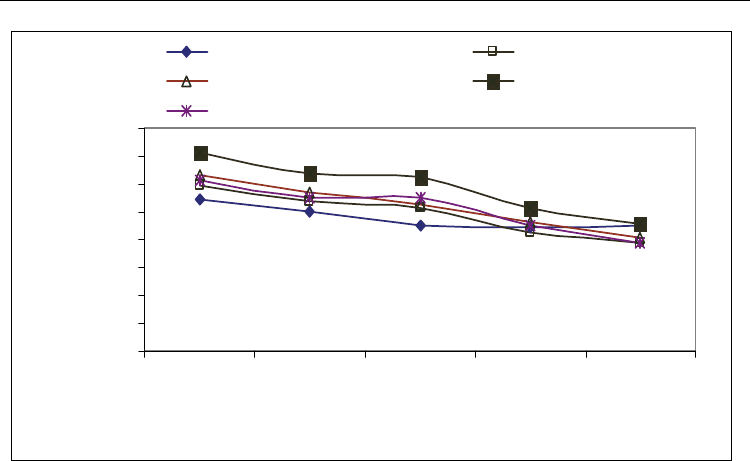
Carbon Nanotubes - Synthesis, Characterization, Applications
458
0
0.02
0.04
0.06
0.08
0.1
0.12
0.14
0.16
30 60 90 120 150
Thermal diffusivity (mm^2/s)
TPNR TPNR+ 1%MWNTs2
TPNR+ 3% MWNTs2 TPNR+ 5% MWNTs2
TPNR+ 7%MWNTs2
Fig. 14. Thermal diffusivity of the composites with different volume fractions of MWNTs 2
(second type) at different temperature
3.4.3 Specific heat
The temperature dependence behavior of the specific heat of the composites is different
from that of their thermal diffusivity, which decreased with the temperature. The specific
heat of all the measured samples increases linearly with the measured temperature from 30
°C to 150 °C. The addition of MWNTs 1 decreased the specific heat, as expected, from the
relatively high specific heat of the matrix, as shown in Figure 15. The specific heat capacity
of the composites was influenced by the filler content. It decreased with the increasing filler
content, 1% and 3 % have shown high specific heat capacity compared with 5% and 7%. The
phonon mean free path is determined by both the phonon-phonon and the phonon-defect
interactions. However, its specific heat increases a little with an increase in temperature,
while the phonon mean free path decreases, which makes its thermal conductivity first
increase and then decrease with temperature.
From Figure 16, the specific heat increased by increasing the MWNTs 2, with a sharp peak at
90°C. This means that the maximum energy is required to change the temperature of
material one degree at this temperature. This is clear from the figure of thermal conductivity
of MWNTs 2. The most important factor affecting the specific heat is the lattice vibrations or
phonons, which means the vibration at this temperature is the maximum, as mentioned
before, also the structure of the material. Thus, change in dislocation density, grain size, or
vacancies have little effect.
The major mechanism of the specific heat enhancement induced by the CNTs addition is not
well understood. It may be related to the multi-walled structure of MWNTs in which the
weak interlayer coupling can exhibit anything from 1D to 3D behavior, depending on the
detailed value of the radius and number of wall (Benedict et al., 1996). However, the

Reinforced Thermoplastic Natural Rubber (TPNR) Composites
with Different Types of Carbon Nanotubes (MWNTS)
459
interface between the boundaries of the matrices or CNTs and matrices, or nanotube-
nanotube will also affect the heat capacity.
0
1
2
3
4
5
6
0 20 40 60 80 100 120 140 160
Temperature°C
Cp/(J/g/K)
TPNR TPNR+1%MWNTs1
TPNR+3%MWNTs1 TPNR+5%MWNTs1
TPNR+6%MWNTs1
Fig. 15. Specific heat of the composites with different volume fractions of MWNTs 1 (first
type) at different temperatures
0
0.5
1
1.5
2
2.5
3
3.5
4
4.5
30 60 90 120 150
Cp (J/g/K)
TPNR TPNR+ 1%MWNTs 2
TPNR+ 3%MWNTs 2 TPNR+ 5%MWNTs 2
TPNR+ 7%MWNTs 2
Fig. 16. Specific heat of the composites with different volume fractions of MWNTs 2 (second
type) at different temperatures
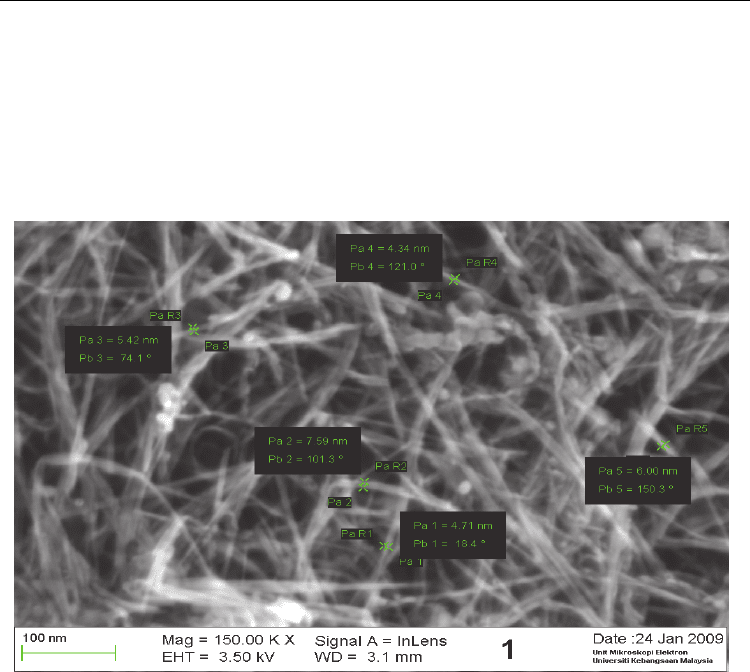
Carbon Nanotubes - Synthesis, Characterization, Applications
460
3.4.4 Morphological examination
Figure 17 and Figure 18 show MWNTs (first and second type) as-received, with a large
agglomeration of bundles of MWNTs, the carbon nanotubes tend to aggregate to form
bundles because of the strong van der Waals forces (many graphene layers wrapped onto
themselves). In addition, the Figures show the diameter of the walls of the MWNTs (the
diameter of the first type is from 4-7nm, and the diameter of the second type is from 7-
15nm). The SEM micrograph of TPNR is shown in Figure 19. This figure shows the TPNR
without a filler inside it, and so the surface is smooth.
Fig. 17. SEM micrograph of MWNT 1 (first type).
The homogenous dispersion of MWNTs in the composites is confirmed by scanning electron
microscopy (SEM). Figure20, Figure 21, Figure 24 and Figure 25, show 1wt% and 3wt% of
MWNTs 1 and MWNTs 2, respectively, they are well dispersed as individual tubes in the
matrix (the bright dots are the ends of broken MWNTs, indicated by arrows), they also show
that the nanotubes that had pulled out from the matrix were still coated with polymer. In
addition, the bright spots inside the TPNR, suggestion a strong polymer nanotubes
interfacial. The key parameter to improve the composites containing the nanotubes is their
uniform dispersion (Sandler et al., 1999; Yoshino et al., 1999). This is often conducted in two
steps. One is to reduce the aggregate (the tangled MWNTs) size. The second is to
homogenize the individual nanotubes and the aggregates in the matrix. Therefore, strong
interfacial adhesion is essential for efficient stress transfer from the matrix to the nanotubes.
This supports our observation of the higher efficiency of carbon nanotubes in enhancing the
properties of TPNR nanocomposites. Figure 22 and Figure 26 show the SEM image of TPNR
with 5wt% of MWNTs 1 and MWNTs 2. They depict an aggregate in TPNR, which observes
a large amount of MWNTs that are self-organized in bundles. Low magnification was
necessary in Figure 23 (7wt% MWNTs 1) and Figure 27 (7wt% MWNTs 2) to observe the

Reinforced Thermoplastic Natural Rubber (TPNR) Composites
with Different Types of Carbon Nanotubes (MWNTS)
461
poor dispersion of nanotubes in the TPNR. The small circles in the figures clearly show a
large number of unbroken carbon nanotubes, (many zones with very high local MWNTs
concentrations), indicating a poor polymer/nanotube adhesion, which contributes to a
reduction in the properties of TPNR/MWNTs nanocompsites.
Fig. 18. SEM micrograph of MWNT 2 (second type).
Fig. 19. SEM micrograph of TPNR.

Carbon Nanotubes - Synthesis, Characterization, Applications
462
Fig. 20. SEM micrograph of TPNR with 1% MWNTs 1.
Fig. 21. SEM micrograph of TPNR with 3% MWNTs 1.
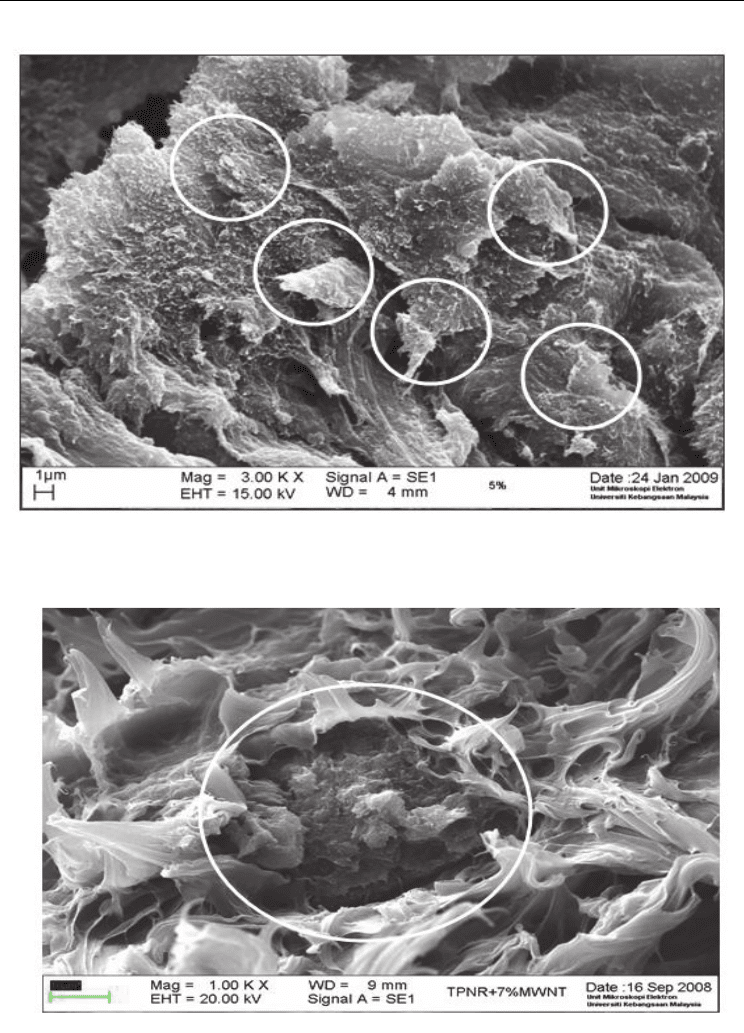
Reinforced Thermoplastic Natural Rubber (TPNR) Composites
with Different Types of Carbon Nanotubes (MWNTS)
463
Fig. 22. SEM micrograph of TPNR with 5% MWNTs 1.
Fig. 23. SEM micrograph of TPNR with 7% MWNTs 1.
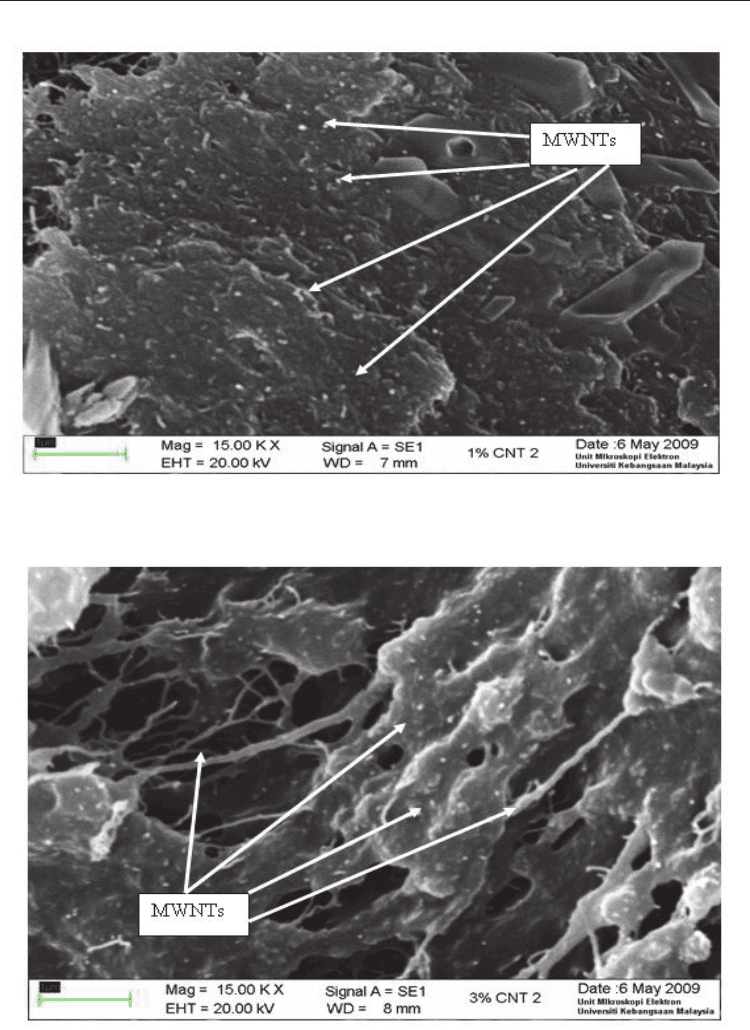
Carbon Nanotubes - Synthesis, Characterization, Applications
464
Fig. 24. SEM micrograph of TPNR with 1% MWNTs 2.
Fig. 25. SEM micrograph of TPNR with 3% MWNTs 2.
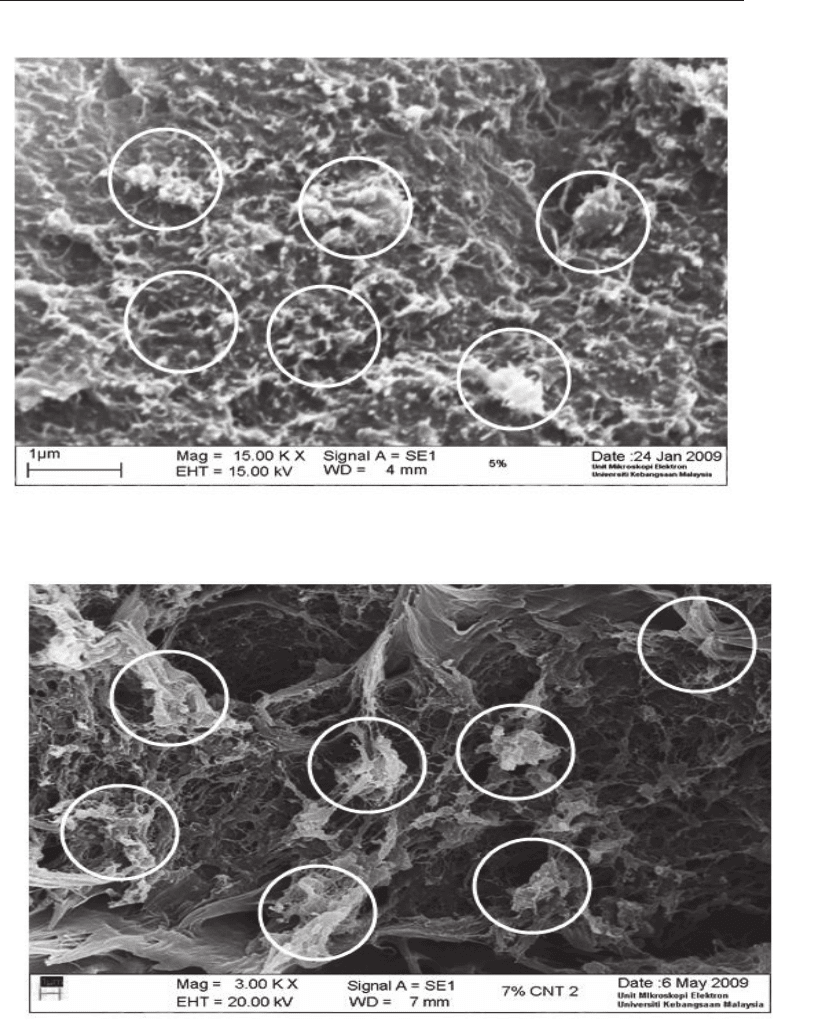
Reinforced Thermoplastic Natural Rubber (TPNR) Composites
with Different Types of Carbon Nanotubes (MWNTS)
465
Fig. 26. SEM micrograph of TPNR with 5% MWNTs 2.
Fig. 27. SEM micrograph of TPNR with 7% MWNTs 2.

Carbon Nanotubes - Synthesis, Characterization, Applications
466
4. Conclusion
In this work, the MWNTs 1 and 2/TPNR nanocomposites were fabricated and the tensile
and properties were measured. The addition of MWNTs in the TPNR matrix improved the
mechanical properties. At this percent the tensile strength and elongation at break of
MWNTs 1 increased by 23%, and 29%, respectively. The Young's modulus had increased by
increasing the content of MWNTs. For MWNTs 2 the optimum result of tensile strength and
Young's modulus was recorded at 3% which increased 39%, and 30%, respectively.
However, elongation of break decreased by increasing the amount of MWNTs. The results
exhibited better impact strength for MWNT 1 and MWNT 2 at 5 wt% with an increase of
almost 70 % and 74%, respectively. The reinforcing effect of two types of MWNTs was also
confirmed by dynamic mechanical analysis where the addition of nanotubes have increased
in the storage modulus E', and the loss modulus E'' also the glass transition temperature (Tg)
increased with an increase in the amount of MWNTs. The laser flash technique was used to
measure the thermal conductivity, thermal diffusivity and specific heat, from the results
obtained. The high thermal conductivity was achieved at 1 wt% and 3 wt% of MWNTs
compared with TPNR after 3 wt% it decreased, also the improvement of thermal diffusivity
and specific heat was achieved at the same percentage. The homogeneous dispersion of the
MWNTs throughout the TPNR matrix and strong interfacial adhesion between MWNTs and
matrix as confirmed by the SEM images are considered responsible for the significant
mechanical enhancement.
5. Acknowledgment
The authors would like to thank Universiti Kebangsaan Malaysia (UKM) for financial
support, science fund Grant UKM-OUP-NBT-29-142/2011 and UKM-OUP-FST-2011.
6. References
Abdullah, I. & Ahmad, S. (1992). Liquid NR as a compatibilizer in the blending of NR with
PP. Mater. Forum. Vol.16, No.1, pp.353-357, ISSN 0255-5476
Abdullah, I. & Dahlan, M. (1998). Thermoplastic natural rubber blends. Prog. Polym. Sci.
Vol.23, No.4 , pp.665-706, ISSN 0079-6700
Abdullah, I., Ahmad, S. & Sulaiman, C.S. (1995). Blending of natural rubber with linear low-
density polyethylene. J. Appl. Polym. Sci. Vol.58, No.7, pp.1125-1133, ISSN 0021-8995
Benedict, L.X., Louie, S.G. & Cohen, M.L. (1996). Heat capacity of carbon nanotubes. Solid
State Comm. Vol.100, No.1, pp.177-80. ISSN 0038-1098
Bin Zhang , Ruowen Fu , Mingqiu Zhang , Xianming Dong , Bin Zhao ,Lichang Wang ,
Charles U. Pittman Jr. (2006). Studies of the vapor-induced sensitivity of hybrid
composites fabricated by filling polystyrene with carbon black and carbon
nanofibers. Composites: Part A. Vol.37, No. 11, pp.1884–1889. ISSN 1359-835X
Cai, H., Yan, F.Y. & Xue, Q.J. (2004). Investigation of tribological properties of
polyimide/carbon nanotube nanocomposites. Mater. Sci. Eng. A.Vol.364, No.1-2,
pp.94–100. ISSN 0921-5093
Canche-Escamilla, G., Rodriguez-Laviada, J., Cauich-Cupul, J.I., Mendizabal, E., Puig,
J.E.&Herrera-Franco, P.J. (2002). Flexural, impact and compressive properties of a
rigid-thermoplastic matrix/cellulose fiber reinforced composites. Compos. Part (A):
Appl. Sci. & Manufact. Vol.33, No.4, pp. 539-549. ISSN 1359-835X
